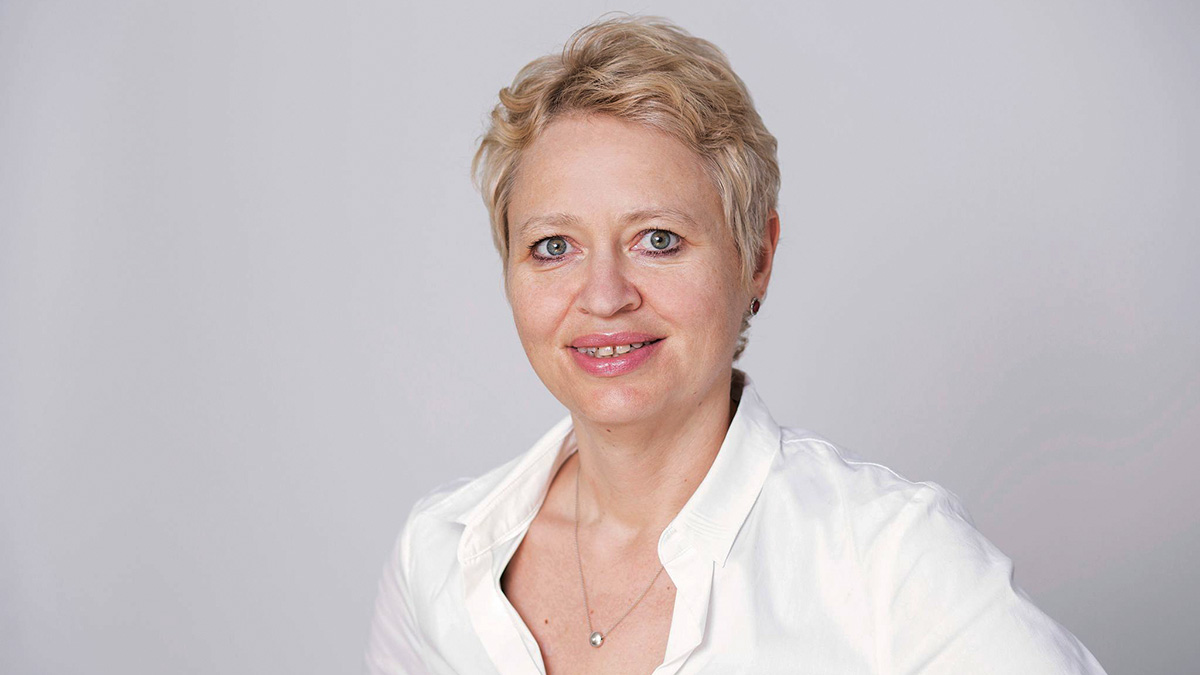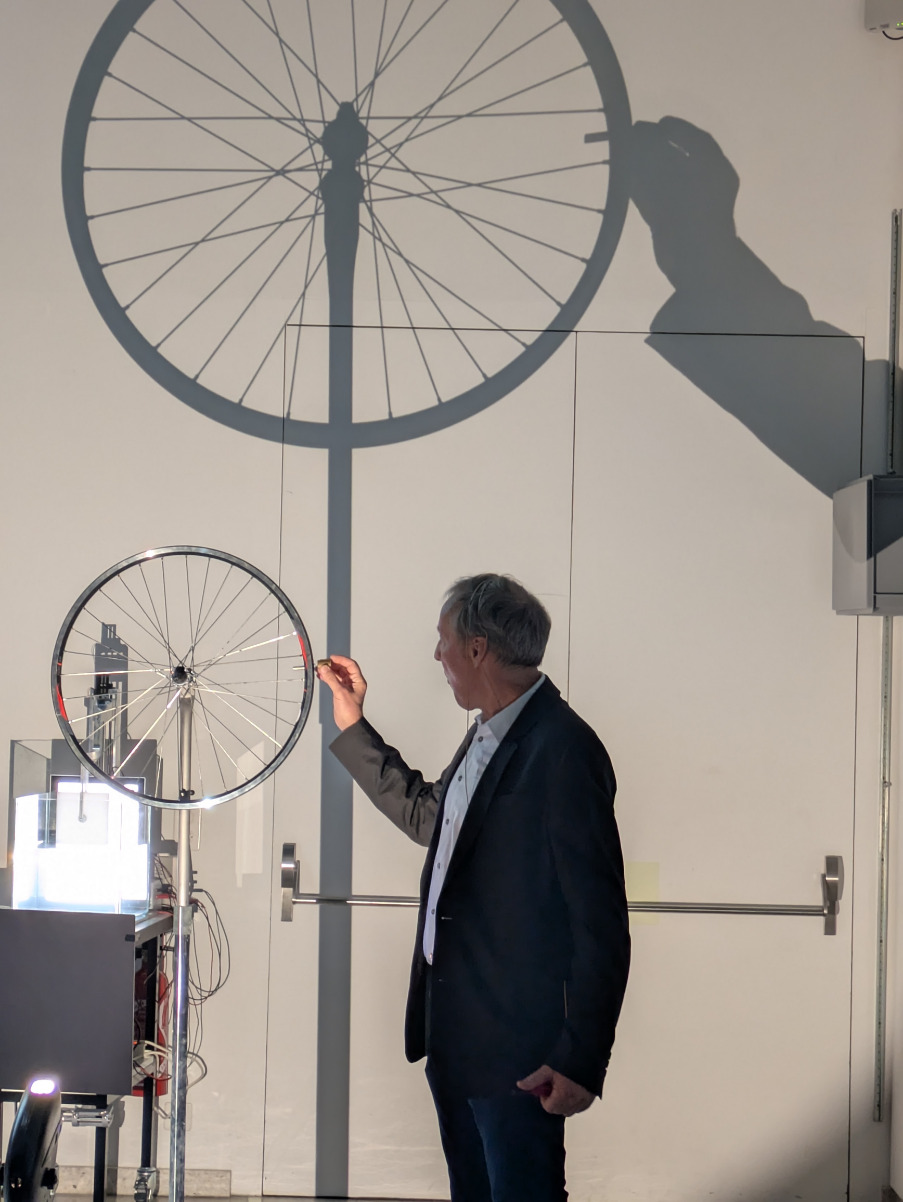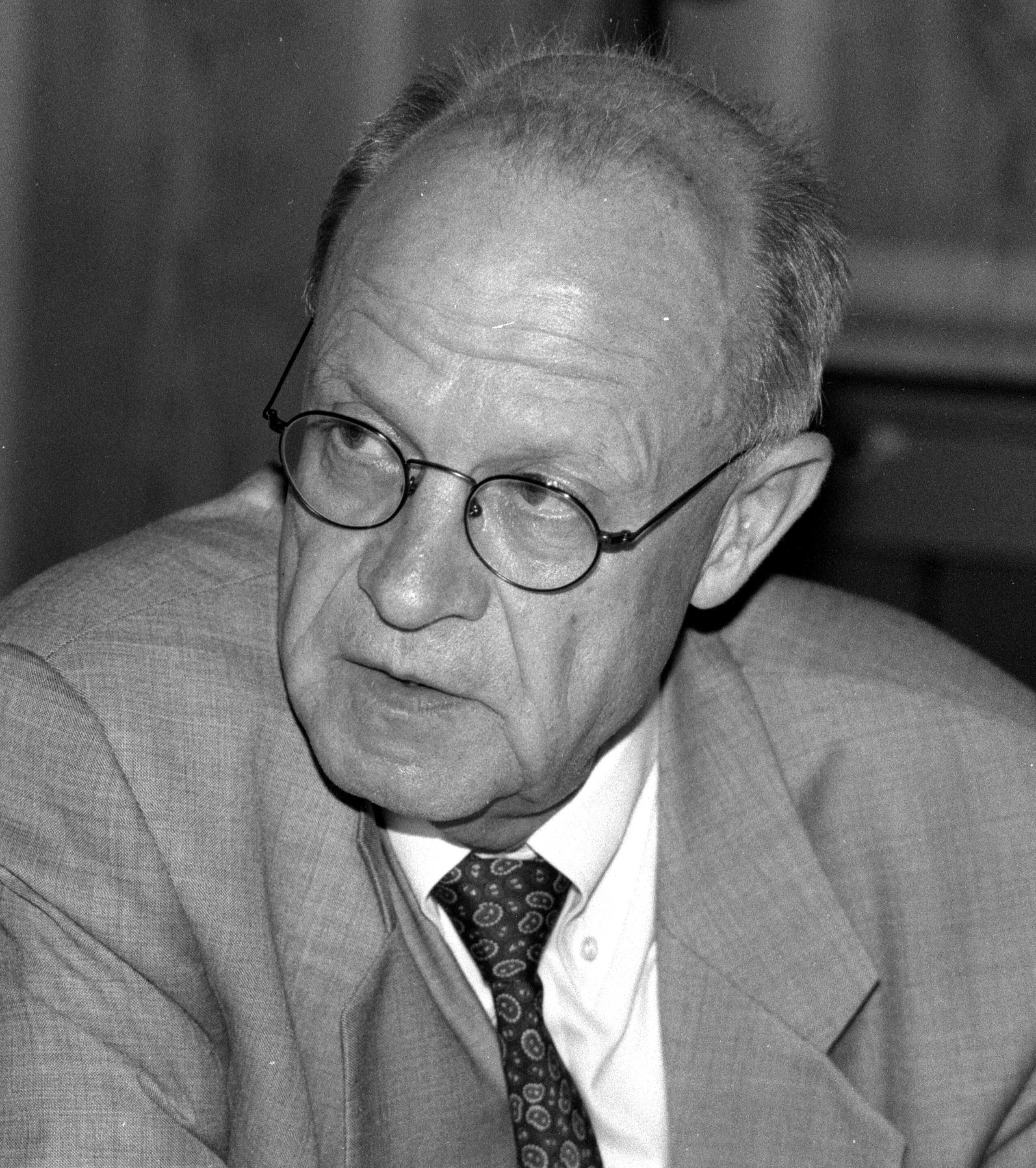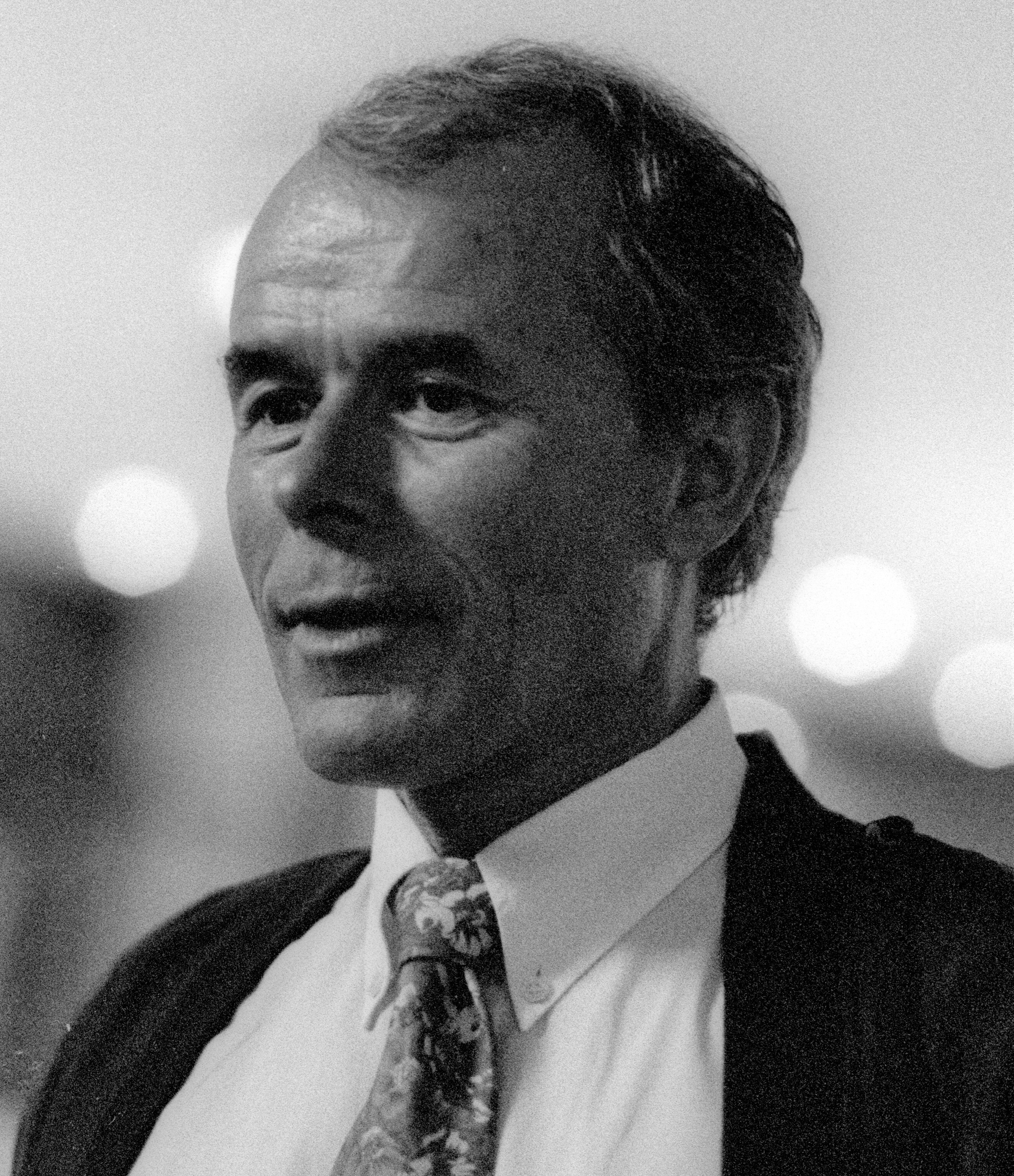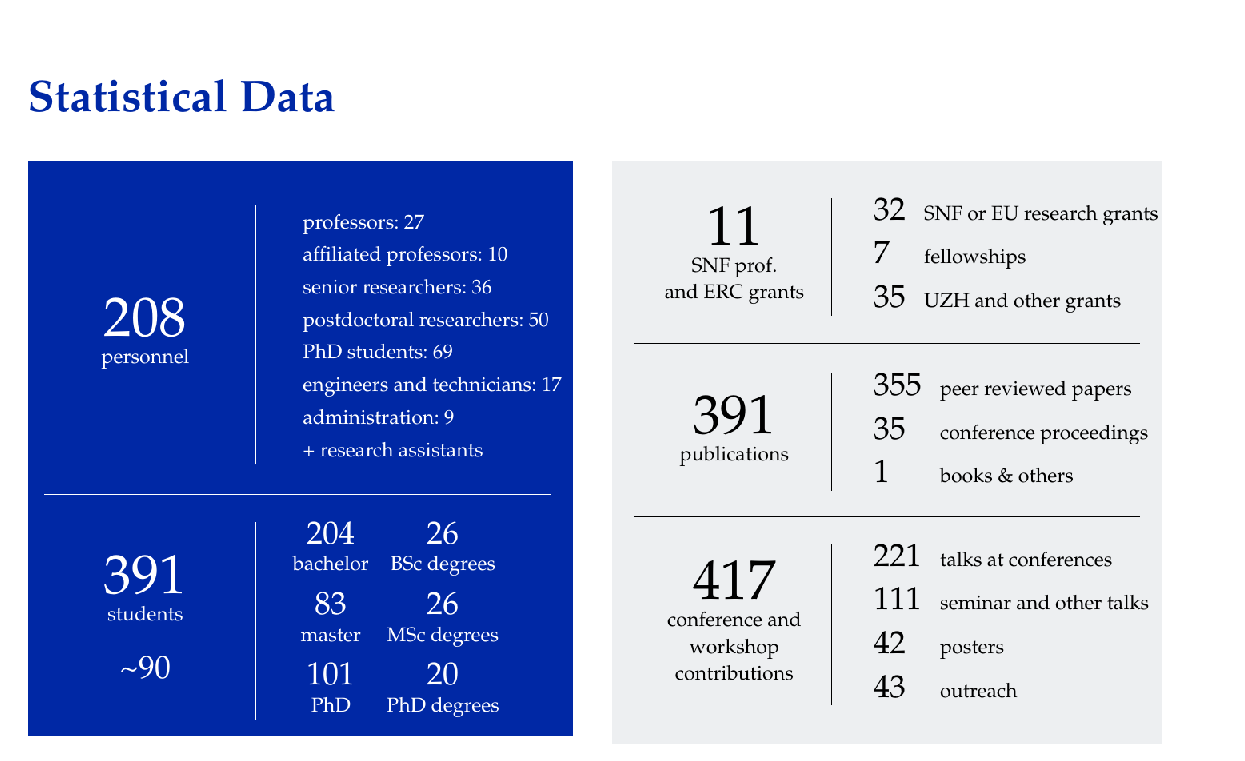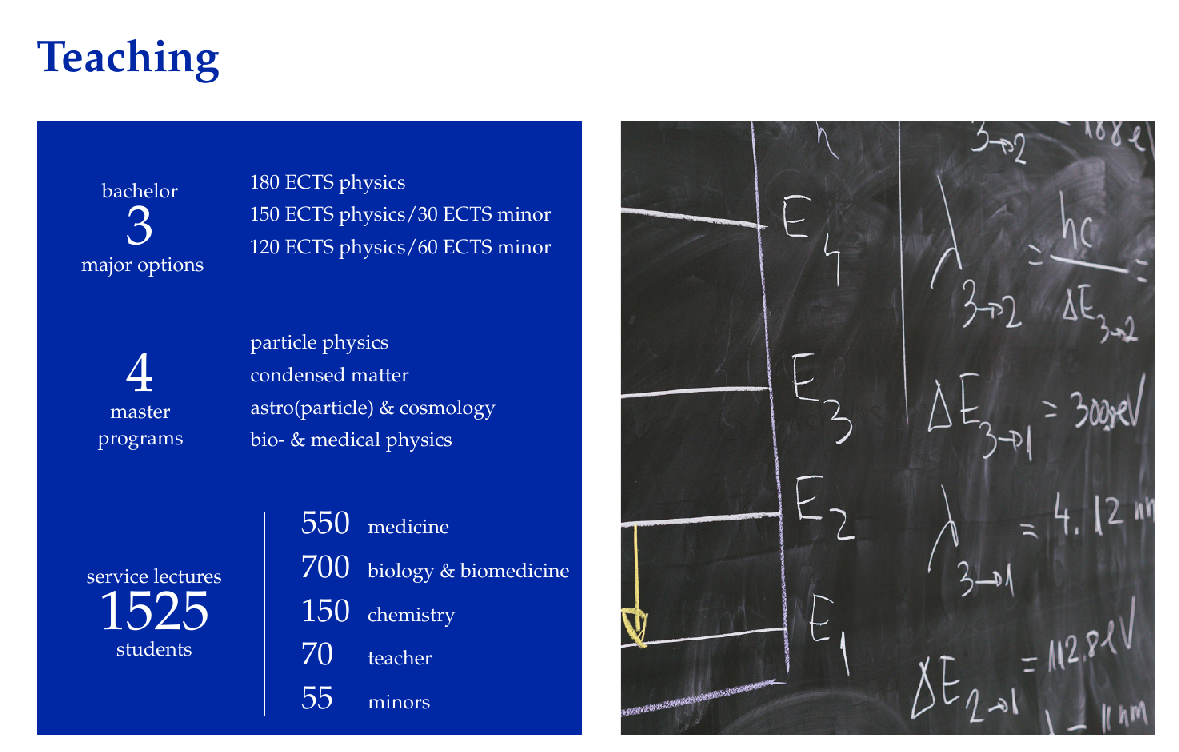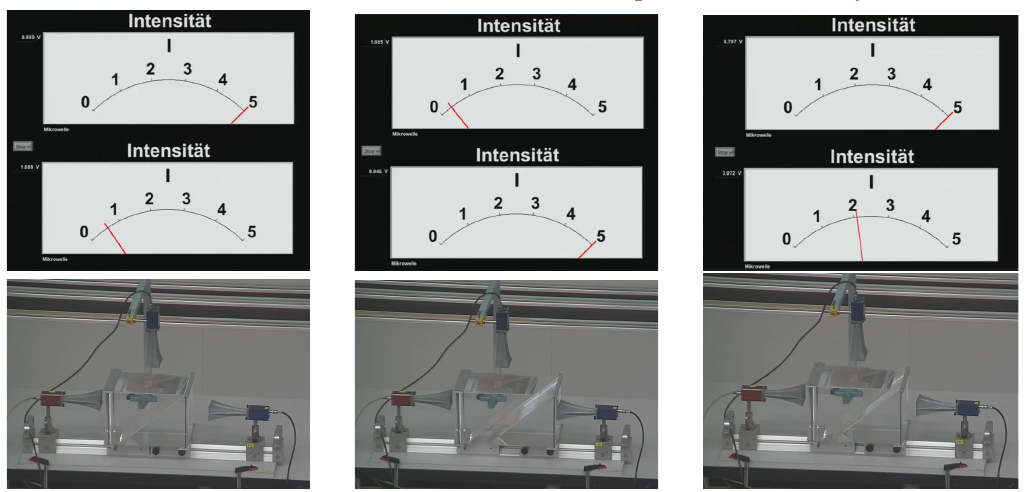Institute

Table of contents
Preface - Laura Baudis, Department Head
With a total of 26 research groups, the Department of Physics at the University of Zurich covers a broad spectrum of physics subfields. Our experimental activities span particle and astroparticle physics, hard and soft condensed matter physics, surface physics and nanoscience, as well as the physics of biological systems. On the theoretical side, our researchers explore quantum chromodynamics and physics beyond the Standard Model, astrophysics and general relativity, and topological phenomena in condensed matter systems. We are also proud to be affiliated with physics-related research groups from across the Faculty of Science and beyond, all of which are linked on our website. Together, we offer a rich and diverse academic program, including high-quality lecture courses and a wide array of Bachelor, Master, and semester projects. The department’s excellence is supported by outstanding infrastructure: state-of-the-art mechanical and electronics workshops, a skilled IT team, and efficient administrative support—all of which contribute to our vibrant and collaborative research environment.
In 2024, we were delighted to welcome three new research groups to the department: two in experimental astroparticle physics and one in experimental condensed matter physics. Marcelle Soares-Santos focuses on uncovering the nature of the Universe’s accelerated expansion through data from the most extensive sky surveys ever conducted. Her group plays a leading role in the construction of the DES camera and in the search for optical counterparts to gravitational wave events. Björn Penning and his group work on direct dark matter detection with the cutting-edge LZ and TESSERACT experiments, as well as the next-generation XENON-LZ-DARWIN detector. Johanna Nordlander is a leader in oxide materials research. Her group explores quantum materials by design through thin-film epitaxy, opening new possibilities in material discovery.
As in previous years, our department hosted an open day in November, welcoming alumni to tour the laboratories, visit the mechanical workshop, and engage with a poster exhibition by our early-career researchers. We also inaugurated a new exhibition, UZHN/Earth, in the Science Pavilion UZH, featuring works by our artist-in-residence, Gina Gibson.
We were especially pleased that the University of Zurich awarded an honorary doctorate to Prof. Dr. Beate Heinemann (University of Hamburg and DESY) in recognition of her pioneering contributions to the search for new phenomena and the development of particle accelerators. Prof. Heinemann also delivered this year’s Schrödinger Colloquium, a flagship event founded and organized by our department.
Sadly, in 2024, we also bid farewell to Günther Rasche (1934 – 2024) and Wolfgang Jaus (1938 - 2024), long-standing members of our theoretical physics community. Having joined the Institute of Theoretical Physics around 1960, their close and often symbiotic collaboration resulted in influential publications in theoretical elementary particle physics that remain relevant today.
In addition to research and teaching, our department continues to play an active role in outreach and community-building. Highlights include our traditional hiking day and Christmas dinner, as well as events for high-school students, such as dedicated workshops and our annual participation in the International Particle Physics Masterclasses.
This booklet offers a glimpse into the breadth of research and activity within our department. For those seeking more detail, we warmly invite you to explore the individual research group websites. With gratitude, we acknowledge the generous support from the Canton of Zurich, the Swiss National Science Foundation, the European Commission, and other funding bodies that make our scientific endeavours possible.
Retirement -Thomas Greber, Emeritus since March 2025
Thomas has been a member of the Department of Physics since the beginning of 1995, when he helped to establish the newly formed Surface Physics Group and their Lab. Coming directly from a three-year postdoctoral stay in the Lab of Nobel Prize Winner Gerhard Ertl at the Fritz Haber Institute in Berlin, he shaped his own research profile in the following years. His fascination of two-dimensional materials, in particular hexagonal boron nitride and graphene, lead to many ground-breaking publications, to a membership in the European Flagship Programme ’GRAPHENE’, and eventually to the founding of a spin-off company Swiss-BN, run by his collaborators. Another vision he has followed over many years is the control and manipulation of nano-objects by means of macroscopic knobs and dials, exemplified by the use of endofullerene molecules as spin-shuttles and nano-scale multiferroics.
He is a very broadly interested scientist and has always enjoyed discussions with researchers from other fields in physics and beyond. Together with a longstanding friend he has published repeatedly on the subject of relativity, culminating in the publication of their book ’Radical Relativity - an uncommon way to spacetime’ (De Gruyter, March 2025).
Science and Friendships - these two things are important to all of us physicists. For Thomas, it is the combination of the two that marks his long and successful academic career. This not only gave him the opportunity to engage in close friendships with researchers in many parts of the world and to visit remote places informally with local friends - like for example exploring the Atlas mountains in Morocco from a small airplane piloted by a native physicist - but also to engage in numerous joint publications with them. His original and sometimes unconventional ideas often provide new avenues to address and solve a particularly puzzling scientific question or motivate novel experiments. I am not using the past tense here, because I am sure that many of these activities will continue after his retirement.
The public lecture that he gave on February 28 on the occasion of his retirement reflected very well his own personal approach to engage in research. Most impressive was the never-ending list of collaborators in the trailer of his presentation.
Jürg Osterwalder
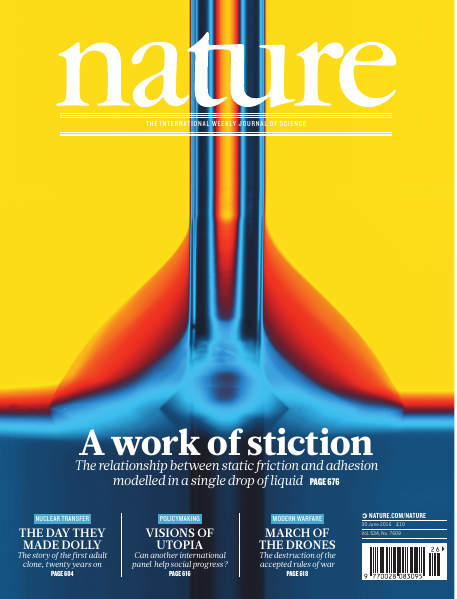
A publication about stiction and adhesion of a liquid on a solid can be reversibly switched using electrochemical potentials, enabling friction control for micro- and nanotechnology applications made it to the cover page of Nature.
In Memoriam Prof. em. Dr. Günther Rasche (5 May 1934 – 14 July 2024)
Günther Rasche was Professor of Theoretical Physics at the Institute of Theoretical Physics at the University of Zurich from 1967 until his retirement in 2001.
Günther Rasche (1934 - 2024) joined the University of Zurich in 1956 as a student in physics. At that time, Walter Heitler (1904 - 1981), one of the leading figures in European physics, was working at the University of Zurich, attracting many physicists from all over Europe, among them Günther Rasche.
Günther Rasche was born on 5 May 1934 in Mülheim an der Ruhr. He studied physics and business administration in Göttingen from 1953 to 1956. His in-depth knowledge of the latter would later have a positive impact on the well-being of the Institute of Theoretical Physics. In 1956, he moved to Zurich, where he graduated in experimental physics under Hans Staub in 1958. In 1961, he obtained his doctorate under Walter Heitler with the dissertation ‘Untersuchungen zum statistischen Modell der Mesontheorie’. He continued his academic career with postdoctoral positions in Dublin and London, but always returned to the University of Zurich. He became a private lecturer there in 1967, assistant professor in 1968, associate professor in 1969 and full professor of theoretical physics in 1977. In the following years until his retirement, he was several times in Canberra, Australia, as well as in Stockholm as visiting professor. In addition to his research in physics that focussed on nuclear and medium-energy physics, he has increasingly turned his interest to topics in history of science, where his long-standing contacts with Walter Heitler have revealed many interesting findings.
Günther Rasche was not only a dedicated researcher, but also an excellent teacher who took students' difficulties seriously. With his empathy, his straightforward attitude and his interest in organisational issues, he was an outstanding head of the Institute of Theoretical Physics from 1989 to 2001 and Dean of the Faculty of Mathematics and Natural Sciences from 1992 to 1994. Many of his former students, staff and colleagues from all over the world came frequently back to Zurich for visits of their mentor and friend and exchange thoughts.
Günther Rasche's scientific interest was initially characterised by the striking developments in field theory in the 1950s and their applications to mesons and nucleons, the strongly interacting elementary particles known at the time. The quark theory valid today was only in its early beginnings, as were the (non-)abelian gauge theories. In his doctoral thesis, he investigated a specific model for the meson-nucleon interaction with regard to its physical consistency. Rasche then turned to precision calculations for meson-nucleon interactions, often together with his long-time colleagues William Woolcock from Canberra and Geoffrey Oades from Aarhus. The aim of this work was (and still is) to find theoretical predictions or explanations for experiments with high accuracy. He also worked on general questions relating to the mathematical treatment of physical processes. Günther Rasche was always interested in current advances and findings in experimental physics and was a valued contact for experimental groups, both at the Department of Physics at the University and at the Paul Scherrer Institute (PSI).
An important development began around 1970 in collaboration with Wolfgang Jaus. Together they developed a formalism to calculate the electromagnetic corrections to super-allowed beta decays. These decays make it possible to precisely measure one of the fundamental quantities in particle physics, the element Vud of the quark mixing matrix. This quantity is very sensitive to the effects of new (as yet undiscovered) particles and forces. It has been shown that the results of Jaus and Rasche are still valid today and form the foundation of current-day research. For example, the fundamental article by Jaus and Rasche from 1970 has already been cited three times this year, 54 years after its publication.
Günther Rasche, together with his colleagues Wolfgang Jaus, Armin Thellung, Norbert Straumann and Günter Scharf, shaped the Institute of Theoretical Physics from the early 1970s until his retirement at the beginning of the 21st century and introduced generations of physics students to theoretical physics. Even after his retirement, Günther Rasche was an important contact person for his colleagues in matters of university policy, and with his wealth of experience and excellent knowledge of human nature, he made valuable contributions to the further development of Department of Physics at the University of Zurich.
The University of Zurich, colleagues and former students honour the memory of Günther Rasche in gratitude for his contributions to the success and well-being of our institute.
In Memoriam Prof. em. Wolfgang Jaus (14 January 1938 – 4 July 2024)
Wolfgang Jaus was Professor of Theoretical Physics at the Institute of Theoretical Physics at the University of Zurich from 1978 until his retirement in 2002.
In 1960 Wolfgang Jaus (1938 - 2024) came to Zurich as a physics student. At that time Walter Heitler (1904 - 1981), one of the leading figures in European physics, was working at the University of Zurich, attracting many physicists from all over Europe, among them Wolfgang Jaus.
Wolfgang Jaus was born in Marbach am Neckar on 14 January 1938. After attending school in Konstanz, he began his physics studies in Tübingen and continued studying from 1960 at the University of Zurich under the influence of Walter Heitler. Wolfgang Jaus completed his studies in 1966 with a doctorate on the ‘Symmetry Property of the State Vector of two Decaying Particles’ under Heitler. He then continued his academic career at the UZH, which was not unusual at the time, occasionally interrupted by research stays in Ireland and later also in the USA. In 1971 he became a private lecturer and in 1978 a titular professor. Wolfgang Jaus was not only a passionate scientist, he was also a very conscientious teacher whose lectures were always clearly and systematically structured.
Wolfgang Jaus' scientific interests were initially driven by the striking developments in field theory in the 1950s on the one hand and their applications to mesons and nucleons on the other. Wolfgang Jaus's doctoral thesis dealt with a fundamental question, whether decaying particles obey the usual symmetry rules of stable particles, which are either bosons or fermions; Jaus showed that this was not the case. After his doctorate, Jaus then turned more and more to the details of the interactions of mesons and nucleons. In a 1968 paper, he dealt for the first time with electromagnetic radiation corrections to beta decay. This work was subsequently expanded in collaboration with Günther Rasche and led to the now established approach to electromagnetic precision predictions for beta decay. In his research activities, Wolfgang Jaus has continuously extended this approach and applied it to a large number of decay processes.
An important development began around 1970 in collaboration with Günther Rasche, who had been at the institute since 1961. Together they developed a formalism to calculate the electromagnetic corrections to super-allowed beta decays. These decays make it possible to precisely measure one of the fundamental quantities in particle physics, the element Vud of the quark mixing matrix. This quantity is very sensitive to the effects of new (as yet undiscovered) particles and forces. It has been shown that the results of Jaus and Rasche are still valid today and are being further pursued accordingly. For example, the fundamental article by Jaus and Rasche from 1970 has already been cited three times this year, 54 years after its publication.
The University of Zurich, colleagues and former students honour the memory of Wolfgang Jaus in gratitude for his contributions to the success and well-being of our institute.
Statistics
Outreach
Teaching
Demonstration Experiments
A demonstration of tunneling of microwaves
When electromagnetic radiation is reflected from a prism, total internal reflection occurs. Here, we have two prisms that can move relative to each other. When they are in direct contact, radiation passes straight through (left), as there is no change in materials properties along the path. When they are far apart (middle), the edge of the first prism leads to a total internal reflection and all radiation is reflected upwards. However, when the distance is less than a wavelength of the microwaves (4 cm), the radiation can traverse the gap via an evanescent wave (right), which is the same process as that of quantum tunneling and part of the intensity is transmitted, while part of the intensity is reflected.
